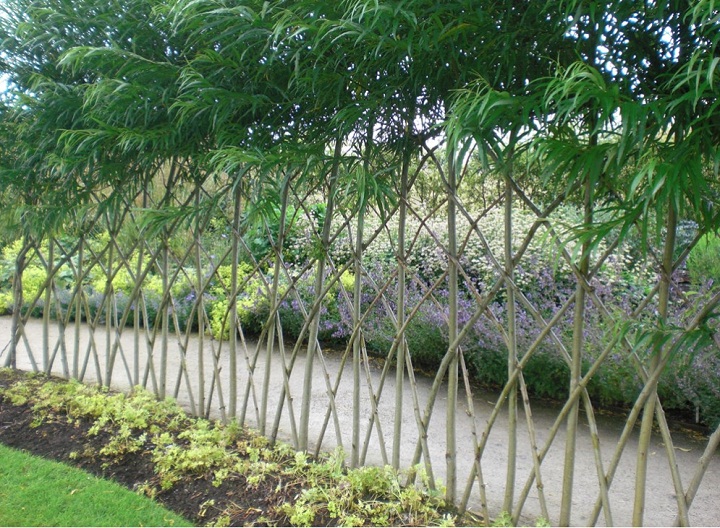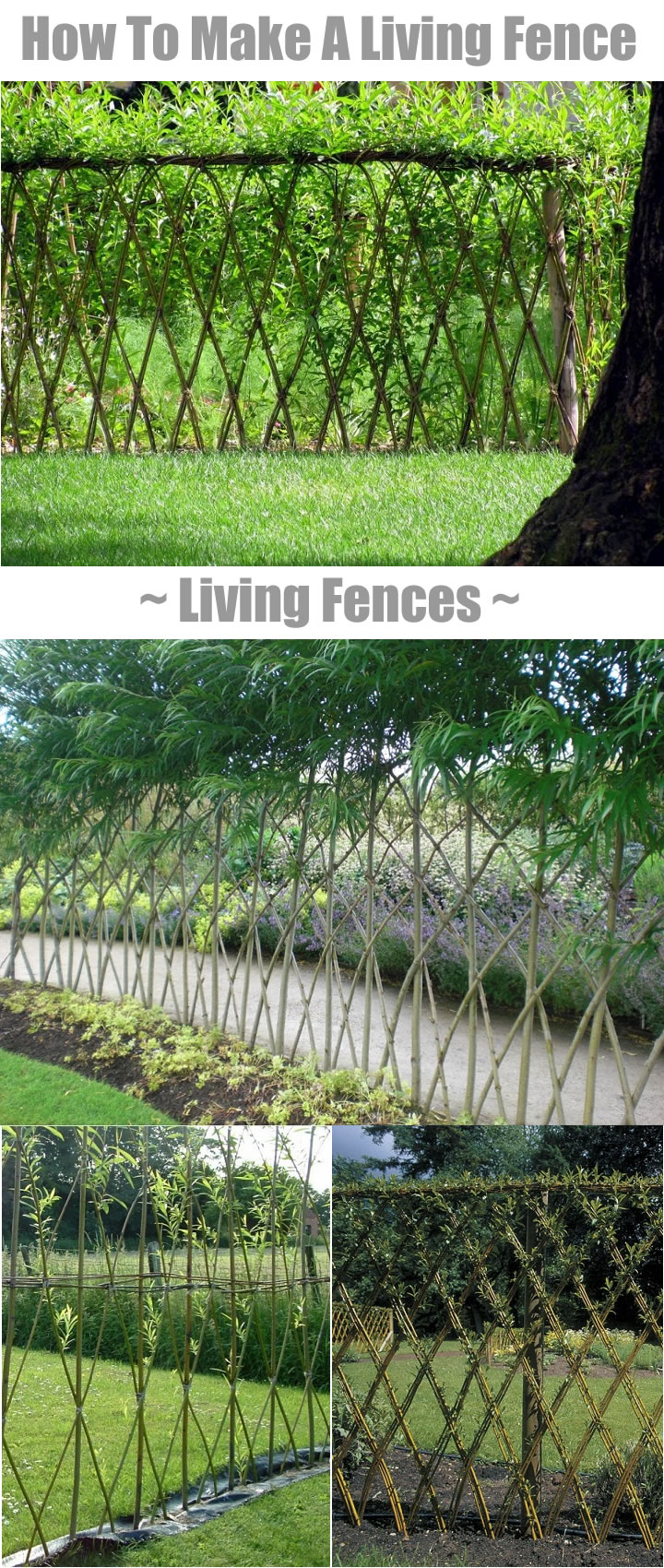Did you know that according to a recent survey, over 70% of gardeners are looking for sustainable and eco-friendly ways to enhance their gardens? If you’re one of them, then creating a living fence might just be the solution you’ve been searching for.
Not only are living fences visually appealing, but they also offer a multitude of benefits for your garden and the environment. From providing habitat for diverse wildlife to reducing soil erosion and even offering shade and sustenance for animals, living fences are a versatile and practical addition to any garden.
But how exactly do you go about making one? In this article, we will guide you through the step-by-step process of creating a living fence for your garden, sharing valuable insights and expert tips along the way. So, if you’re ready to transform your garden into a sustainable haven, keep reading to discover the wonders of living fences and how they can revolutionize your gardening experience.
Living Fences…
- Living fences provide numerous benefits such as supporting ecological diversity, providing food and medicine for livestock, offering shade for animals, fixing nitrogen in the soil, and acting as a windbreak and reducing soil erosion.
- Although not widely used in the United States, historical examples such as George Washington’s honey locust living fences at Mount Vernon showcase their effectiveness in protecting against pests and preserving enclosed areas.
- Different species can be used for living fences depending on climate and intended purposes, with some species offering edible berries or high-protein seeds and pods. Living fences can serve multiple functions such as defense, fuel, and food sources.
- While there are some disadvantages, such as labor-intensive establishment and maintenance, living fences can be a sustainable and environmentally friendly alternative to manufactured fences, contributing to a more self-sufficient and ecologically conscious agriculture.
Benefits of Living Fences
Living fences offer a multitude of benefits that can enhance both the ecological diversity and practicality of your garden.
When it comes to wildlife conservation, living fences provide valuable habitat for various species. Birds can nest in the dense foliage, while small mammals find shelter and food among the shrubs and trees. This promotes biodiversity and creates a sense of belonging for these creatures in your garden.
Additionally, living fences can bring economic benefits to farmers. They act as a natural windbreak, reducing soil erosion and protecting crops. The shade provided by the living fence also helps to keep livestock cool, reducing stress and increasing productivity.
By incorporating living fences into your garden, you aren’t only creating a beautiful and functional space, but also contributing to wildlife conservation and sustainable farming practices.
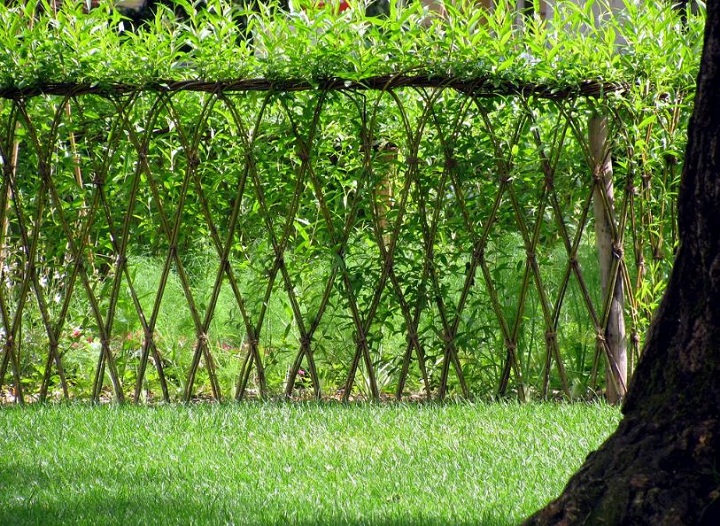
Historical Use of Living Fences in America
As we delve into the historical use of living fences in America, it’s fascinating to discover the practicality and ingenuity that led early settlers to incorporate these natural barriers into their landscapes.
While living fences have been used in other parts of the world for centuries, their cultural significance in America can’t be understated. Early settlers recognized the need for protection against deer and other pests, and living fences provided a cost-effective solution.
George Washington himself used honey locust trees at Mount Vernon, taking advantage of their close spacing and formidable nature. Osage orange trees were also extensively used to fence the prairies before the invention of barbed wire, as they were tolerant of various soils and resistant to drought.
These living fences not only served as a barrier but also provided durable fence posts and deterred deer and livestock with their sharp thorns. It’s clear that living fences played a significant role in shaping the American landscape and their cultural significance can’t be ignored.
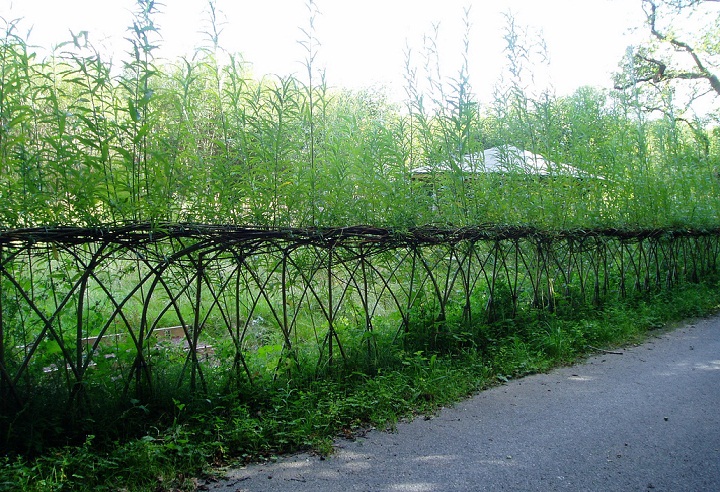
Establishing Living Fences
To establish a living fence, you need to carefully select and plant the appropriate shrub or tree species. Consider hawthorns, pyracanthas, or jujube for their versatility and ability to provide both defense and food sources. There are a magnitude of other options too (see table below).
Once you have chosen your species, there are two key techniques to employ: pruning and inosculation. Pruning techniques, such as regularly trimming back the saplings, encourage thick growth and a dense barrier.
Inosculation, on the other hand, involves tying crossing branches together to allow natural grafting. This method strengthens the fence over time, creating a more resistant and resilient living barrier.
By combining these methods, you can create a living fence that not only serves its purpose but also adds beauty and ecological diversity to your garden.
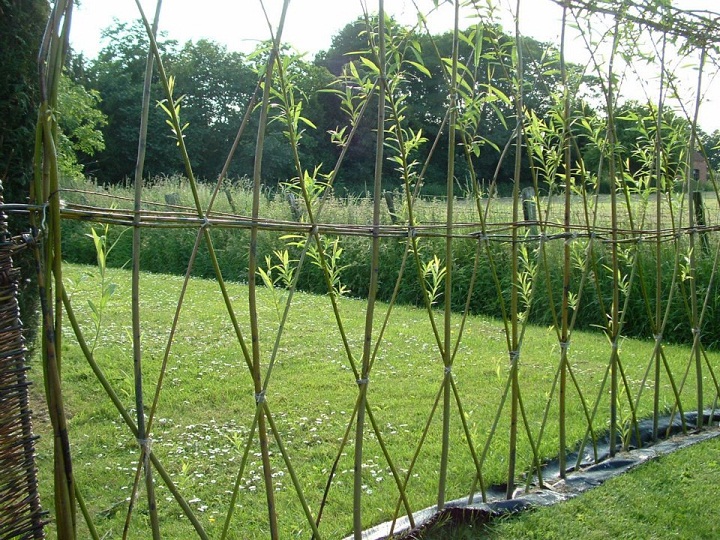
‘Did You Know? Living fences have been used for centuries in different cultures around the world, including ancient Rome and medieval Europe. They weren’t only practical for livestock containment but also served as a natural defense against intruders.’
Multifunctional Options for Living Fences
When it comes to creating multifunctional living fences, the key lies in selecting the right combination of species that can provide a range of benefits while enhancing the ecological diversity of your garden.
One option is to choose species that offer edible options for your living fence. For example, hawthorns, pyracanthas, jujube, and rugosa rose can all provide delicious berries or high-protein seeds and pods.
Another option is to get creative with the design of your living fence. You can mix different species to create a visually appealing and productive fence. Consider combining fruit or nut trees with species like rugosa rose or berry brambles. This way, you not only have a beautiful fence, but also a source of harvestable food.
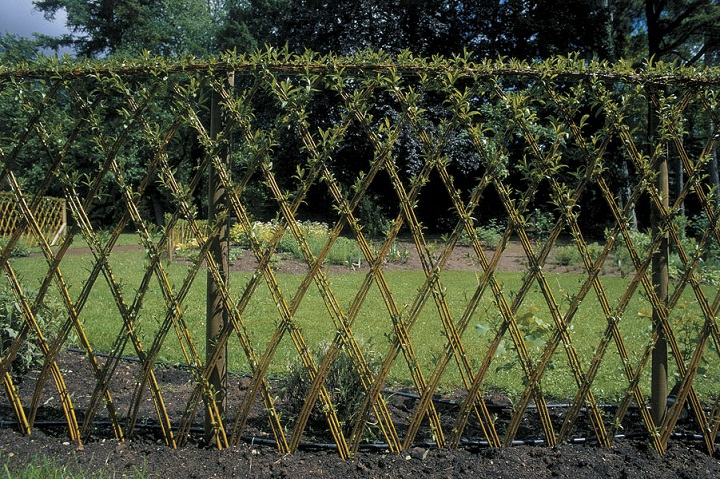
Advantages and Disadvantages
Living fences offer a multitude of advantages and disadvantages that are important to consider when incorporating them into your garden. Here are some pros and cons of using living fences in gardening and agricultural settings:
Advantages of using living fences in gardening:
- Living fences provide a natural and aesthetically pleasing boundary for your garden, enhancing its overall beauty and charm.
- They act as a windbreak, reducing the impact of strong winds on delicate plants and creating a more favorable microclimate.
- Living fences attract beneficial wildlife like birds and butterflies, promoting biodiversity and creating a harmonious ecosystem in your garden.
Disadvantages of using living fences in gardening:
- Establishing living fences can be labor-intensive, requiring careful planning, planting, and maintenance.
- Protection from weeds, deer, and other pests is necessary during the early stages, which can add to the workload.
- Regular pruning of mature fences may be required to maintain their shape and prevent them from becoming overgrown.
Pros of using living fences in agricultural settings:
- Living fences provide a sustainable source of livestock fodder and fuel, reducing the need for external inputs.
- They act as a natural barrier, protecting crops and livestock from wind, soil erosion, and potential predators.
- Living fences can contribute to a more environmentally friendly and self-sufficient agriculture, aligning with sustainable farming practices.
Cons of using living fences in agricultural settings:
- Establishing living fences on a larger scale can be time-consuming and require significant resources.
- Additional protection measures may be necessary to prevent damage from larger herbivores, such as deer or livestock.
- Regular maintenance and pruning of mature fences may be needed to ensure their effectiveness and longevity.
Incorporating living fences into your garden or agricultural setting can provide numerous benefits, but it’s important to weigh these advantages and disadvantages to make an informed decision.
‘Did You Know? Living fences have been used for centuries by various cultures around the world. In medieval times, hedgerows were commonly used in Europe to mark boundaries and provide shelter for crops and livestock.’
The Future of Agricultural Fencing
The future of agricultural fencing is rapidly changing as farmers and landowners recognize the numerous benefits of living fences. These sustainable alternatives to traditional fences provide a range of advantages for both the environment and farming practices.
One of the key benefits of living fences is their ability to support ecological diversity by creating edge habitat. This promotes the growth of various plant and animal species, leading to a more balanced and thriving ecosystem.
In addition to supporting biodiversity, living fences also contribute to soil conservation. They help reduce soil erosion by acting as a natural barrier against wind and water. Furthermore, living fences have the unique ability to fix nitrogen in the soil, providing a natural fertilizer for surrounding crops and vegetation.
As awareness of these benefits continues to grow, an increasing number of farmers are incorporating living fences into their agricultural practices. They’re realizing that these fences not only serve as functional boundaries but also contribute to a more sustainable and environmentally friendly approach to farming.
Different Trees For Living Fences
Here is a table that includes a list of popular types of trees used to create living fences, along with their benefits, benefits pros, and cons:
| Tree Type | Benefits | Pros | Cons |
|---|---|---|---|
| Thuja Green Giant | Fast growth, dense foliage | Provides privacy and noise reduction | Requires regular pruning |
| Leyland Cypress | Fast-growing, evergreen | Good windbreak and privacy screen | Prone to diseases and pests |
| Bamboo | Fast-growing, sustainable | Provides privacy and noise reduction | Can spread aggressively if not contained |
| Osage Orange | Dense thorny branches | Effective at deterring intruders | Slow growth, requires regular maintenance |
| Holly | Dense evergreen foliage | Provides privacy and wildlife habitat | Requires regular pruning |
| Arborvitae | Evergreen, low-maintenance | Provides privacy and noise reduction | Susceptible to aphids and spider mites |
| Boxwood | Dense foliage, easy to shape | Provides privacy and aesthetic appeal | Can be susceptible to disease |
| Privet | Fast-growing, adaptable | Provides privacy and wildlife habitat | Requires regular pruning |
| Hawthorn | Thorny branches, wildlife habitat | Effective at deterring intruders | Slow growth, requires regular maintenance |
| Willow | Fast-growing, flexible | Provides privacy and windbreak | Requires regular pruning and maintenance |
| Juniper | Evergreen, drought-tolerant | Provides privacy and aesthetic appeal | Can be susceptible to diseases |
Please note that the suitability and performance of these trees may vary depending on factors such as climate, soil conditions, and maintenance practices. It’s always recommended to consult with a local expert or nursery to determine the best tree options for your specific location.

How to Start an Osage Orange Living Fence
To start an Osage Orange living fence, begin by collecting Osage oranges in the fall and exposing them to freeze-thaw cycles. This process enhances germination by breaking down the hard seed coat. Once the freeze-thaw cycles have been completed, plow a furrow in the desired location during the fall and let the soil mellow over winter.
In the spring, mash the fermented oranges into a thick slurry and dribble it along the furrow. Partially backfill the furrow with soil to cover the seeds, and thin the seedlings if necessary. In the second fall, weave the seedlings together in the trench to create a densely woven living fence.
Osage orange, also known as hedge apple, is an ideal species for living fences due to its unique characteristics. It has sharp thorns that deter deer and livestock, making it an effective natural barrier. Osage orange is also tolerant of various soils and resistant to drought, making it suitable for different climates. Additionally, it coppices vigorously and provides durable fence posts.
Creating a mixed species living fence offers even more benefits. By combining different species, you can enjoy a harvest of edible berries or high-protein seeds and pods. Mixed species living fences also provide a diverse habitat that supports ecological diversity and acts as a windbreak, reducing soil erosion. The weaving of pliable branches from multiple species creates a living fence that isn’t only functional but also visually appealing, adding beauty and a sense of belonging to your garden.
‘Did you know? Osage orange wood is one of the hardest and most durable woods in North America. It has been used for centuries to make tool handles, fence posts, and even archery bows’
Living Tree Fences…
Creating a living fence for your garden or farm is a sustainable and eco-friendly way to enhance your outdoor space. Not only do living fences provide aesthetic appeal, but they also offer a wide range of benefits for your garden and the environment. So the next time you’re looking at creating a fence, why not consider making it a living one.
